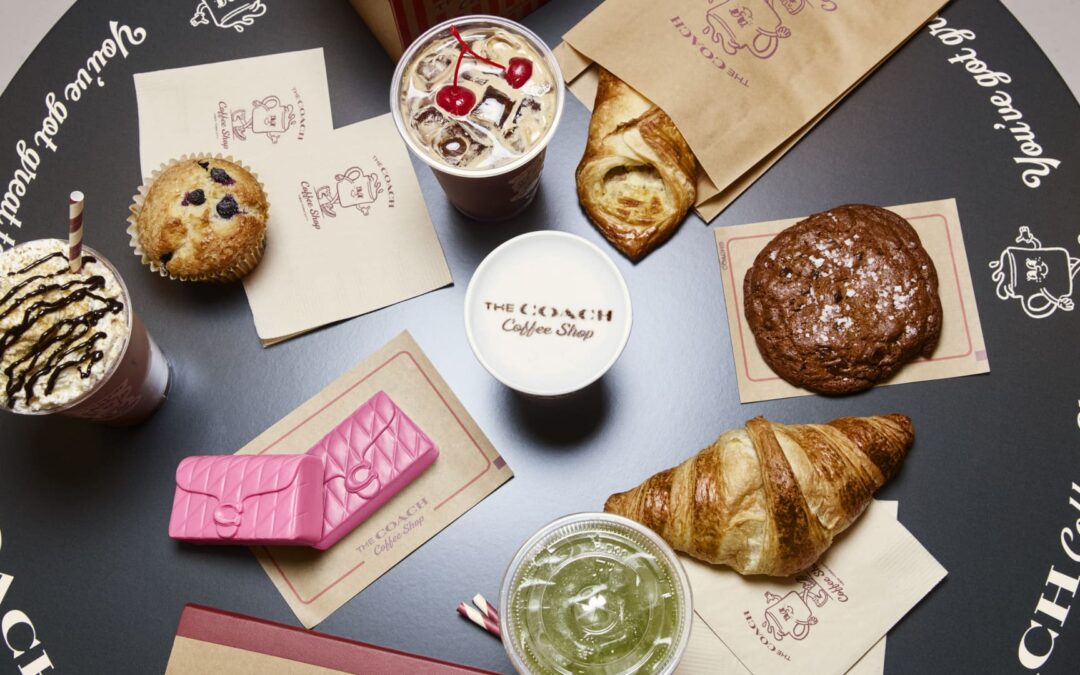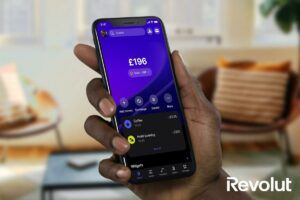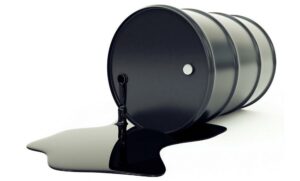With its new coffee shop, Coach wants to drive more frequent trips to its stores and solidify its gains with Gen Z shoppers. One of its menu items is a Tabby Cake, a cake pop-inspired dessert that’s in the shape of Coach’s Tabby purse.
Courtesy: Coach
At Coach’s new shops, the latest purse is made of cake batter and colorful shades of white chocolate.
The legacy leather handbag maker’s recent venture is a coffee shop that offers Tabby purse-shaped sweets, tiramisu- and pumpkin-flavored coffees, matcha drinks and more. Each shop is attached to a store that sells Coach’s lineup of handbags, sneakers and other apparel and accessories.
On Friday, the company opened another location of The Coach Coffee Shop – the third in the U.S. – in The Mills at Jersey Gardens, an outlet mall roughly 16 miles southwest of New York City. Coach will open the fourth in Woodbury Common Premium Outlets, also in the greater New York City area, on Oct. 3.
It plans to open about 12 to 15 coffee shops each year around the world, while also adding to the menu, rotating seasonal food and drinks and selling exclusive tote bags and other merchandise, said Marcus Sanders, vice president of global food and beverage at Coach.
With the coffee shops, the Tapestry-owned fashion brand wants to build on recent gains with shoppers, particularly Gen Z, by giving customers more reasons to keep coming back to its stores.
“We understand the consumer today loves experience,” Coach CEO Todd Kahn said. “They want a full experience, particularly the young consumer.”
Coach isn’t the only retailer that has tried to create experiences for customers. Ralph Lauren has coffee shops called Ralph’s and a restaurant, The Polo Bar. Luxury furniture and home decor retailer RH has opened restaurants across the country and even a hotel, which it calls RH Guesthouse, in New York City. And Uniqlo opened its first coffee shop in North America earlier this year inside of its clothing store on New York City’s Fifth Avenue.
Coach Coffee Shop
Courtesy: Coach
Sanders, who previously worked for Starbucks and Ralph Lauren Hospitality, said coffee shops offer a friendlier price point than Coach merchandise, especially for young teens. On a recent visit to The Coach Coffee Shop in Austin, Texas, he said he saw two teen girls split a Tabby Cake in half and clink the pieces against one another in a cheers while recording a TikTok video.
Some of those teens don’t have the budget now for a handbag, but may become future shoppers, Sanders said. And even older customers have limits on how many fashion purchases they can make in a month or year, he said.
“You can afford a coffee more often,” he said. “So I think that’s what we’re excited about is our customers being able to visit us more often.”
Building on Gen Z growth
Coach is trying to seize upon brand momentum that’s fueled sales growth, brought in new customers and sparked stock gains. The company has driven up the average paid by shoppers for its products at a time when many retailers are relying on promotions. Its bag charms have trended on TikTok and its Large Kisslock Frame Bag, which retails for $695, sold out even before Carrie Bradshaw carried it in an episode of HBO Max’s “Sex & the City” spinoff, “And Just Like That.”
Shares of its parent Tapestry, which also includes struggling brand Kate Spade, have climbed about 67% so far this year or about 600% over the past five years.
Coach has gained particular traction with Gen Z, which roughly spans ages 13 to 29. The retailer said it attracted 4.6 million new customers in North America in the most recent fiscal year ended June 28, including over 1 million in the fourth quarter. Nearly 70% of those new customers in the past fiscal year were Gen Z and millennials, the company said.
Coach has also blurred the distinction between its retail channels with those younger shoppers’ behavior in mind. It dropped the word “outlet” from the signs outside its outlet stores and is selling more of its best-known, full-price items at those locations along with the ones in flashier destinations like New York’s Fifth Avenue.
Kahn said it began experimenting with the approach about two years ago, but added more full-price merchandise to outlets last year after learning customers were racing to their nearest store for a Coach item they’d seen on social media and finding it wasn’t there.
“Since Covid, particularly for this younger generation, there’s a return to in real life shopping and malls and outlets are part of that equation,” he said in a CNBC interview. “They see the TikTok image. They see what they want. They’re like, ‘I want to go get that.'”
At an investor day this month, Kahn said he and the company have continued to study the shifting behavior of shoppers, especially the likes and dislikes of Gen Z. On a recent plane ride, he said he watched Netflix’s animated movie “KPop Demon Hunters,” a choice that he joked probably surprised the passengers next to him.
He said at the investor day that Coach is on track to become a $10 billion brand, though he didn’t give a timetable. That will take sharp growth for Coach, which posted annual revenue of about $5.6 billion in the most recent fiscal year.
Dana Telsey, retail analyst and CEO of Telsey Advisory Group, said Coach has gained ground by sharpening its marketing and developing collections of items — such as its Tabby bags or Soho sneakers — that attract a following but continue to come out in new fabrics and colors.
Plus, she said ultra-luxury handbag players have raised prices significantly, which has given Coach the ability to hike its own prices while still seeming like a good deal.
“It’s the quality and the fashion aesthetic that to me has differentiated it and allowed consumers to say, ‘This is worth it,'” she said.
Yet Coach now has another reason to focus on maintaining its pricing power. Higher tariffs will cost its parent company $160 million in the coming fiscal year and drag on Tapestry’s profits, an update that prompted an investor selloff in August.
How coffee plays into Coach’s strategy
One of those avenues to boost revenue and keep customers coming back will be through the coffee shops. Coach first opened a coffee shop and restaurant in Jakarta, Indonesia. It’s used its southeast Asian market as a testing ground, since the area has a fast-growing middle class and many Gen Z shoppers, Sanders said.
Since then, it opened locations in Tinton Falls, N.J. in December and in Austin, Texas in January. It plans to open new locations in Massachusetts, California, Arizona and Texas, along with parts of the Midwest.
In other parts of the world, it has opened 16 coffee shops, with locations in China, Japan, South Korea and Indonesia.
Coffee shops are connected to the Coach store and designed to encourage shoppers to consider other purchases along with their drink or snack, said Leigh Manheim Levine, president of Coach North America. For example, she said Coach set up the display of its best-known bags — such as the Tabby and Brooklyn — within eyesight of customers when they are standing at the cashier to buy a coffee.
She said the shops will be profitable businesses on their own. So far, their merchandise has been a major sales driver, accounting for about 30% of the coffee shops’ overall revenue. The locations sells tote bags, water bottles, pins, sweatshirts and more that are exclusively carried by The Coach Coffee Shop and cost more than a latte.
Many of them, such as a tote bag that retails for $95, feature Lil Miss Jo, a cartoon-like coffee shop logo that the company said was inspired by New York City diners.
Manheim Levine said the exclusivity of the merchandise is part of the appeal.
“They’re shopping with their friends,” she said. “They’re taking pictures. They want to get what other people can’t have.”
Coach Coffee Shop locations sell merchandise, such as tote bags and sweatshirts, along with drinks. The shop’s icon is Lil Miss Jo, a cartoon-like character inspired by New York City diners.
Courtesy: Coach
Most of the new coffee shops in the U.S. will open in outlet malls, Manheim Levine said. Many of its approximately 190 outlets in North America are in malls without food options, which creates more opportunity for the company, she said.
“Why we think our strategy is a winning strategy is that it’s also solving a problem for the customer,” she said.
Sanders said the coffee shops have sparked stronger foot traffic and longer times at stores, encouraging customers to both dine and to buy. And in Coach locations that have a coffee shop, sales have seen a double- or triple-digit increase across the entire store, he said.
On a weekday earlier this month, Desiree Aguilar traveled about an hour and 10 minutes to visit the The Coach Coffee Shop in Tinton, N.J. with her aunt and younger cousin. Aguilar, a 32-year-old radiology technician from Hawthorne, N.J., said she learned about the shop through a TikTok video, which piqued her curiosity — especially since she loves outlet shopping.
After ordering a pumpkin spice latte and a croissant ham and cheese sandwich, Aguilar took a spin around the Coach store with her drink in hand as she browsed the new fall merchandise.
“I liked that I didn’t have to rush to have my drink and could just shop around,” she said.
She left with a new Coach purse and matching wallet, totaling about $200, along with a fresh Instagram post about the coffee shop.









